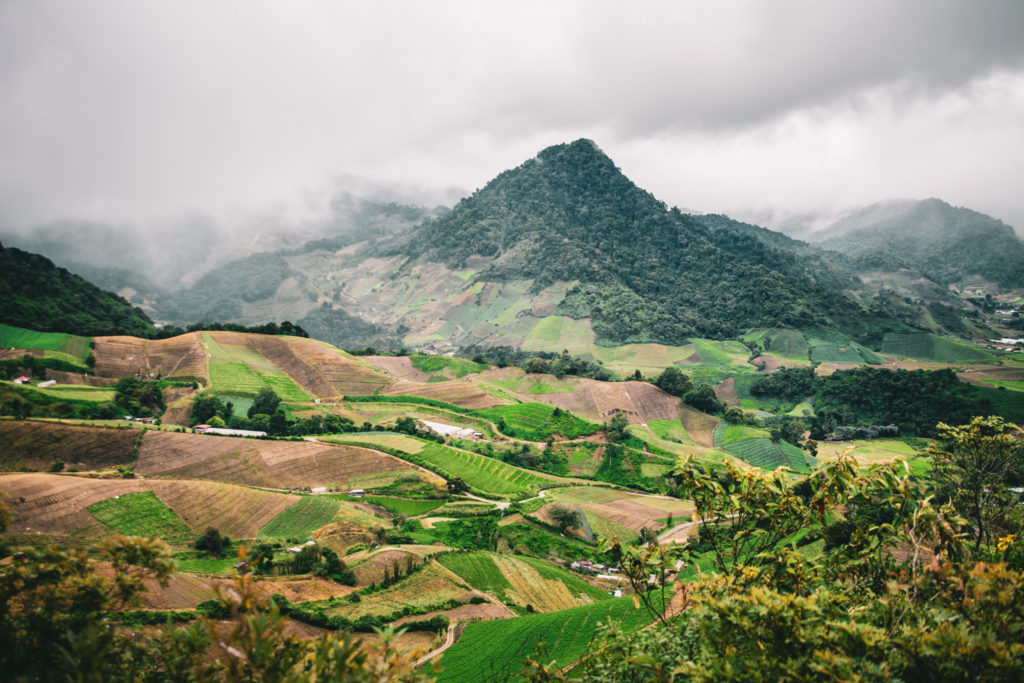
The view from Finca Sophia, Panama. Photo by David Pohl.
Arabica coffee is only found growing in its indigenous environment at elevations between 1000 and 2000 metres above sea level. (Schmitt, Christine B., 2006) But you will find coffee plantations at elevations ranging from sea level to as high as 2800 metres. The reason for this limited growing range is the species’ relatively low tolerance to frost — sustained temperatures below 4° C will kill the plant. Arabica’s susceptibility to fungal pathogens also limits its success at low altitudes, where such microorganisms are more likely to thrive.
The growing altitude correlates directly to the plant’s ideal ‘temperature band’. In other words, successfully growing arabica coffee depends on a delicate balance between altitude and latitude. For optimal cellular respiration to produce good yields and great flavour, agronomist Leonardo Henao states that a daytime temperature between 17 and 23° C is the key factor in optimising coffee metabolism and the storage of sugars in the seed. Outside of this temperature band, the coffee plant is effectively asleep. In the warm, tropical belt, this balance is most often achieved at elevations of between 1000 and 2000 metres above sea level.
Arabica coffee can grow outside the tropics, but in these instances the suitable terroir tends to be found at lower latitudes. An example of this occurs around Byron Bay in Australia, where a subtropical rainforest climate in close proximity to the sea helps to prevent frost. As you may recall from high school geography class, ocean temperatures are far slower to change than the temperatures on land. This is because the specific heat of water is much higher than earth and stone; it takes about five times as much energy from the sun to heat 1 kilogram of water by 1 degree Celsius than it does to heat 1 kg of rock by 1 degree.
An Interview with Willem Boot
Willem Boot is a pioneer of high-altitude farming of the geisha coffee cultivar around Boquete in Panama. In fact, his farm Finca Sophia is said to be the highest-altitude farm in Central America. He has been an influential coffee educator with his school Boot Coffee. Notably, Boot was part of the judging panel who witnessed the rediscovery of geisha in 2004.
—
BH: What is the altitude range of Finca Sophia?
Willem: It ranges from 1900 to 2150 metres [about 6200 to 7000 feet].
BH: In our research we have found some research papers that indicate coffee acidity increases with altitude. Have you taken any measurements that corroborate this? For example, does the coffee at the bottom of your farm have a measurably lower acidity than the coffee from lots on the highest parts of the farm?
Willem: I have never measured or compared this, but most likely the acidity difference will be noticeable.
BH: Can you tell us how high altitude affects the populations of pathogens on your farm compared with other Boquete farms at lower altitudes? Is it still necessary to spray for leaf rust?
Willem: We have no problems whatsoever with leaf rust but, due to the higher and colder conditions, we do have issues with die-back, which manifests itself when the tip leaves turn black.
BH: Is it a tendency that there are fewer insects at higher altitudes? If so, are there any benefits or disadvantages to the plants?
Willem: Yes. Not that I am aware of.
BH: Is there a noticeable difference in soil type or soil nutrition at your altitude compared with that of the farms at lower altitudes?
Willem: Not necessarily. Soil fertility is also very much dependent on previous activities and practices at the farm. At Sophia there were, at some point, cattle, which compacted the soil in some places.
BH: Do you experience problems with increased UV radiation at higher altitudes? If so, is it more important or less important to have shade on your farm, compared with on farms lower down the mountain?
Willem: Yes. Especially, new trees suffer the impact. Having sufficient shade is key, and being able to cut back shade once the tree needs direct sunlight for blossoming is also key.
BH: Do you get higher rainfall by being higher up the mountain?
Willem: No, not necessarily.
BH: Have you experienced frost on your farm? Are there any measures you can take to reduce this risk?
Willem: No, not that I’m aware of. Plant rapid growing, non-invasive plants near the coffee trees. They might be able to facilitate a slightly higher temperature around the coffee trees.
BH: Is there something unique about the geisha variety that makes it well adapted to growing at high altitudes?
Willem: Actually, the flavour of Geisha is amplified at higher elevations, much more than with other varieties. There is no proof that the trees do better higher up the mountain. Geisha has a poor root structure which protects it inadequately against winds, which happens to be a major pain in the ass, especially at higher elevations!
BH: As we understand it, your harvest is often quite a lot later than that of the other Boquete farms, which means they have often carried out the Best of Panama (BOP) grower’s competition before your harvest has even been taken in. In your experience, does slower maturation improve coffee flavour, or are there disadvantages?
Willem: In this scenario, “patience” becomes very important! I can’t think of any disadvantage unless the lengthy ripening takes the cherries into the next season of the year, with lots of rain.
End 1.03